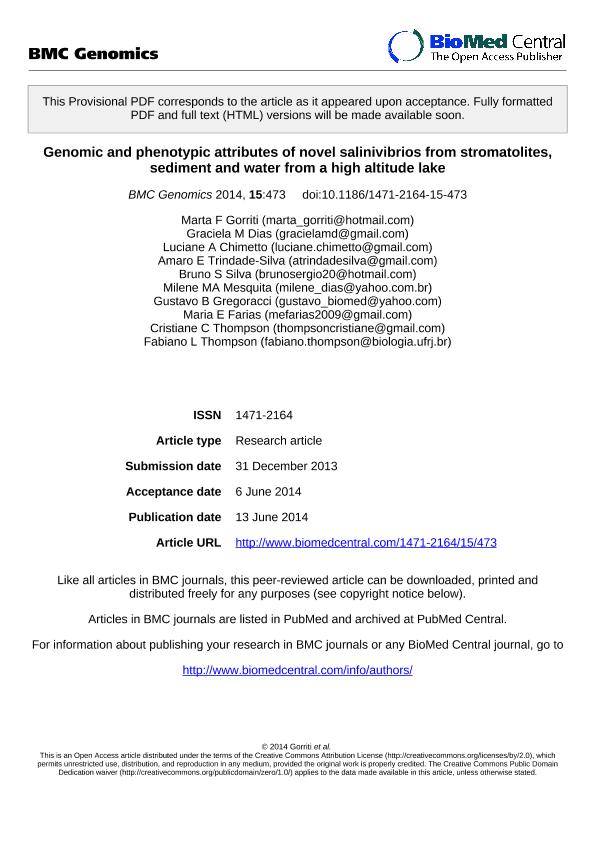Artículo
Genomic and phenotypic attributes of novel salinivibrios from stromatolites, sediment and water from a high altitude lake
Gorriti, Marta Fabiana ; Dias, Graciela M.; Chimetto, Luciane A.; Trindade-Silva, Amaro E.; Silva, Bruno S.; Mesquita, Milene M.A.; Gregoracci, Gustavo B.; Farias, Maria Eugenia
; Dias, Graciela M.; Chimetto, Luciane A.; Trindade-Silva, Amaro E.; Silva, Bruno S.; Mesquita, Milene M.A.; Gregoracci, Gustavo B.; Farias, Maria Eugenia ; Thompson, Cristiane C.; Thompson, Fabiano L.
; Thompson, Cristiane C.; Thompson, Fabiano L.
 ; Dias, Graciela M.; Chimetto, Luciane A.; Trindade-Silva, Amaro E.; Silva, Bruno S.; Mesquita, Milene M.A.; Gregoracci, Gustavo B.; Farias, Maria Eugenia
; Dias, Graciela M.; Chimetto, Luciane A.; Trindade-Silva, Amaro E.; Silva, Bruno S.; Mesquita, Milene M.A.; Gregoracci, Gustavo B.; Farias, Maria Eugenia ; Thompson, Cristiane C.; Thompson, Fabiano L.
; Thompson, Cristiane C.; Thompson, Fabiano L.
Fecha de publicación:
06/2014
Editorial:
BioMed Central
Revista:
BMC Genomics
ISSN:
1471-2164
Idioma:
Inglés
Tipo de recurso:
Artículo publicado
Clasificación temática:
Resumen
Background: Salinivibrios are moderately halophilic bacteria found in salted meats, brines and hypersaline environments. We obtained three novel conspecific Salinivibrio strains closely related to S. costicola, from Socompa Lake, a high altitude hypersaline Andean lake (approx. 3,570 meters above the sea level).Results: The three novel Salinivibrio spp. were extremely resistant to arsenic (up to 200 mM HAsO42-), NaCl (up to 15%), and UV-B radiation (19 KJ/m2, corresponding to 240 minutes of exposure) by means of phenotypic tests. Our subsequent draft genome ionsequencing and RAST-based genome annotation revealed the presence of genes related to arsenic, NaCl, and UV radiation resistance. The three novel Salinivibrio genomes also had the xanthorhodopsin gene cluster phylogenetically related to Marinobacter and Spiribacter. The genomic taxonomy analysis, including multilocus sequence analysis, average amino acid identity, and genome-to-genome distance revealed that the three novel strains belong to a new Salinivibrio species.Conclusions: Arsenic resistance genes, genes involved in DNA repair, resistance to extreme environmental conditions and the possible light-based energy production, may represent important attributes of the novel salinivibrios, allowing these microbes to thrive in the Socompa Lake. © 2014 Gorriti et al.; licensee BioMed Central Ltd.
Palabras clave:
Arsenic
,
Extreme Environment
,
Salinity
,
Uv Radiation
,
Xanthorhodopsin
Archivos asociados
Licencia
Identificadores
Colecciones
Articulos(PROIMI)
Articulos de PLANTA PILOTO DE PROC.IND.MICROBIOLOGICOS (I)
Articulos de PLANTA PILOTO DE PROC.IND.MICROBIOLOGICOS (I)
Citación
Gorriti, Marta Fabiana; Dias, Graciela M.; Chimetto, Luciane A.; Trindade-Silva, Amaro E.; Silva, Bruno S.; et al.; Genomic and phenotypic attributes of novel salinivibrios from stromatolites, sediment and water from a high altitude lake; BioMed Central; BMC Genomics; 15; 1; 6-2014
Compartir
Altmétricas



